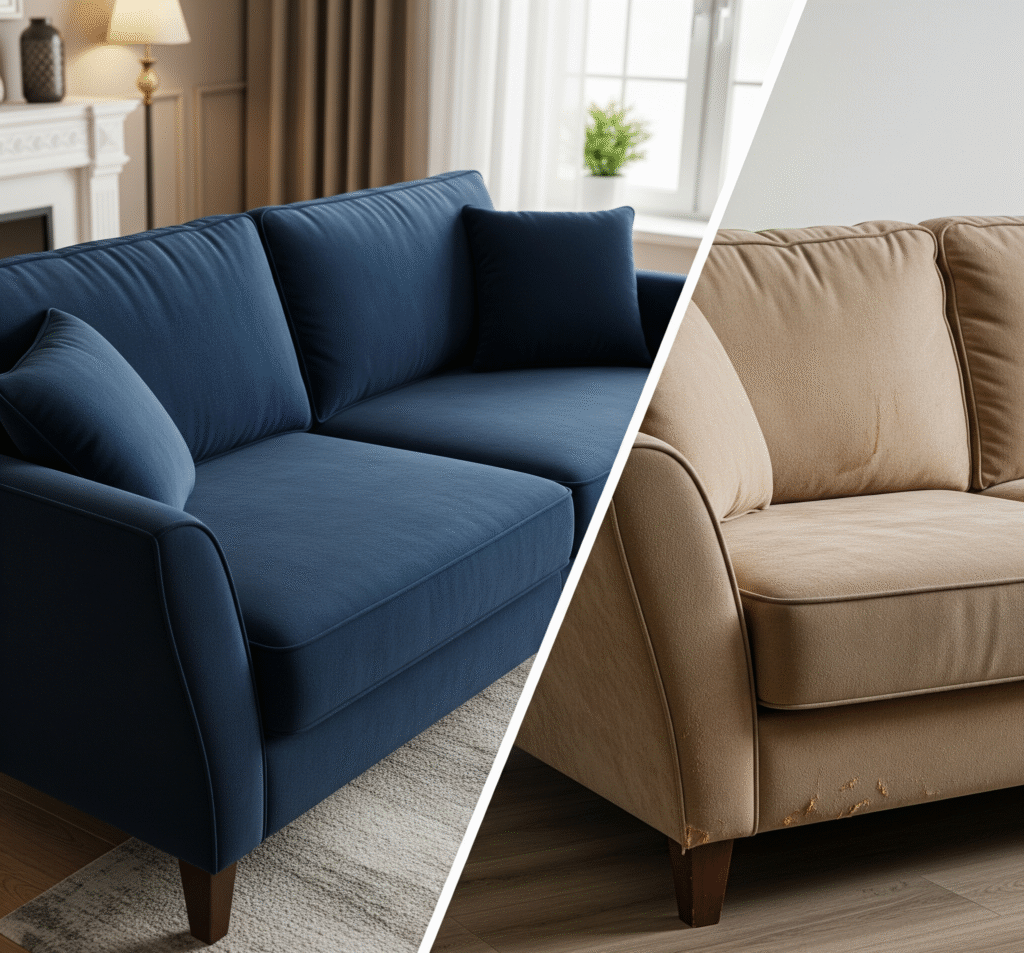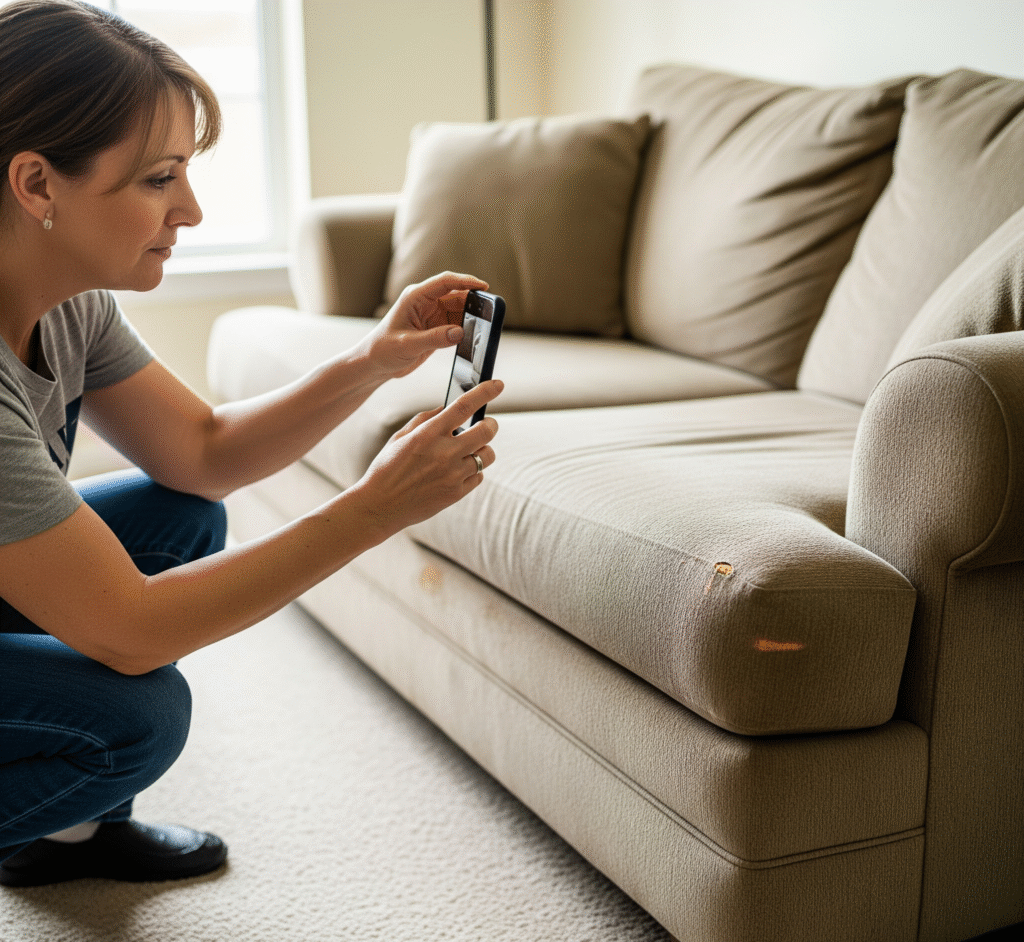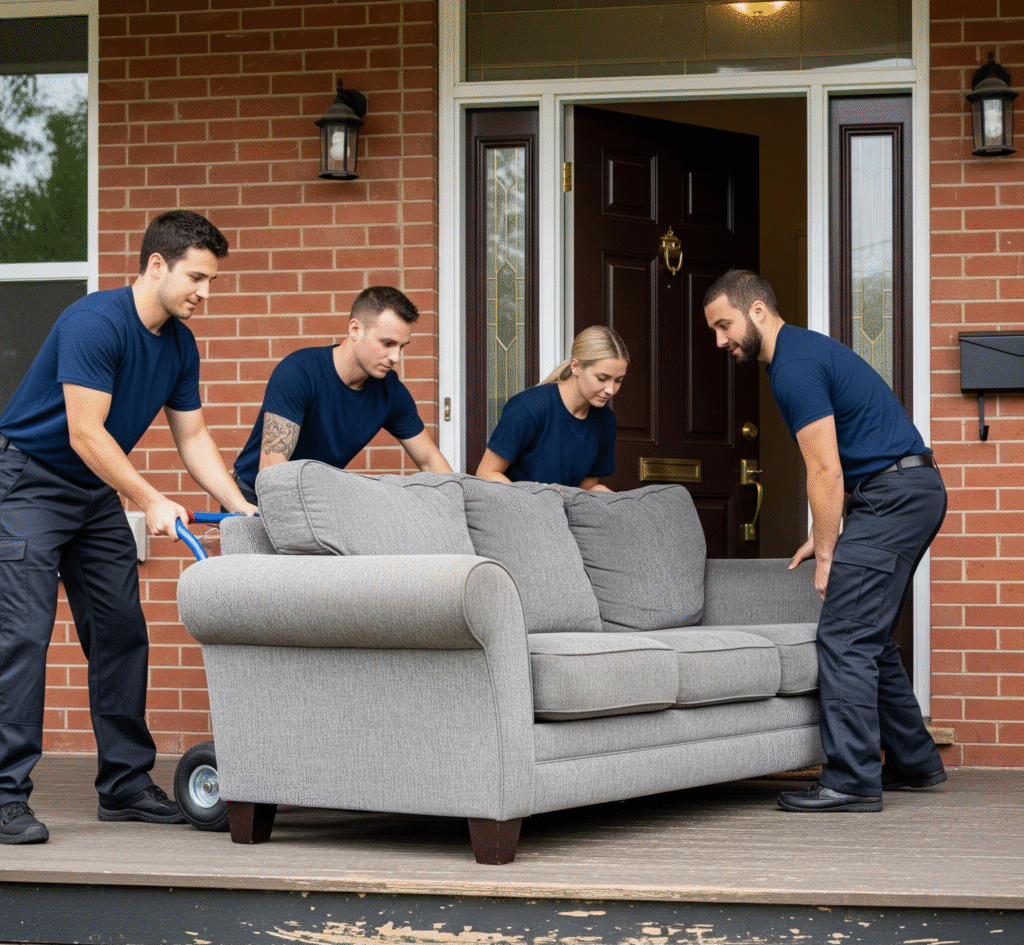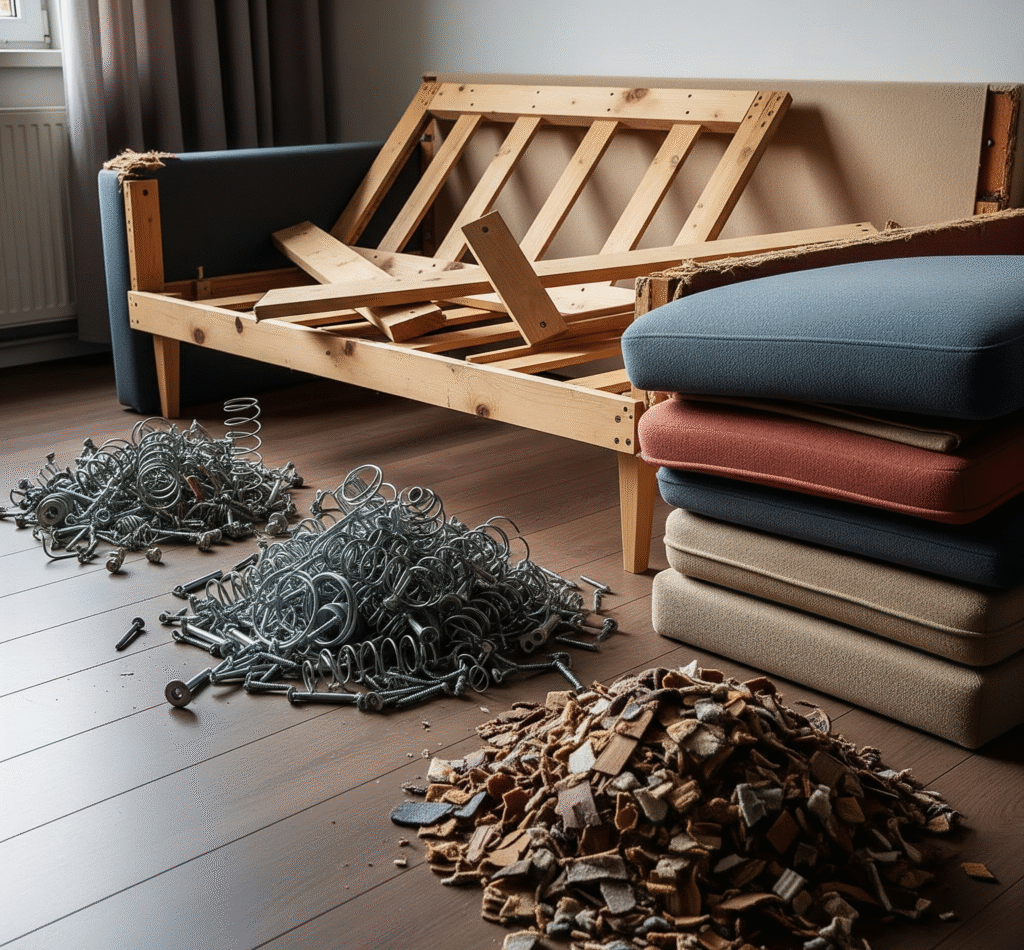Introduction
Dispose of a sofa—but not sure where to start? You’re in good company. Whether furry claws have turned the fabric into a scratchpad or the color clashes with your fresh paint, letting a sofa go can feel trickier than bringing it inside.
But there’s good news: getting rid of your sofa doesn’t have to be hard or costly. With a little know-how, you might even pocket some cash while doing a solid for the planet—and your neighbours.

Relevance: Captures the everyday dilemma many homeowners encounter.
In this post, we’ll show you six simple ways to dispose of your Sofa without creating waste. Whether you want to sell it online, gift it to a charity, or arrange bulk pickup, you’ll find a fit for your schedule, budget, and peace of mind.
Table of Contents
Why Proper Sofa Disposal Matters
First, let us pause and ask why tossing a sofa the right way really counts.
Environmental Impact of Furniture Waste
Every year millions of sofas, chairs, and tables end up in landfills, where they sit for decades before breaking down. When you throw out old furniture the right way, you give the planet a break in four big ways:
– Keep bulky, hard-to-decompose items out of crowded dumps
– Preserve wood, metal, and foam instead of forcing new harvests
– Cut the greenhouse gases linked with making brand-new pieces
– Feed the circular economy by turning trash into something useful
Health Benefits for Your Family
Swapping a flame-retardant sofa for one without those chemicals can slash toxic dust in the air, scientists say. So, getting rid of that old seat may clear the air inside your home.
Community and Social Benefits
Smart disposal usually means passing your furniture on to someone else. Donating it to a shelter or selling it cheap to college students turns your leftover piece into a lifesaver for someone on a budget.
Tip Box: Before choosing donation, sale, or curb pickup, snap clear photos from several angles. Good pictures help buyers, charities, and removal crews see exactly what they’re getting.
Giving Your Couch a Quick Check Before Tossing It
Before you get rid of that old sofa, take a minute to look it over. How beat-up is it? What you find will decide the easiest way to say goodbye.
Quick Condition Checklist
Take a slow lap around your sofa and answer these questions honestly:
Structural Issues:
– Are the legs shaky, cracked, or missing altogether?
– Does the frame groan or bend when you sit down?
– Do the springs press into the seat or sag like a hammock?
Upholstery Problems:
– Are there stains that every cleaner and scrub still can’t lift?
– Is the fabric ripped, threadbare, or coming loose at seams?
– Are there cigarette burns or large faded patches that catch the eye?
Cleanliness and Safety:
– Does the sofa smell musty, sour, or like old gym socks?
– Can you see, or smell, mildew, mold, or water stains anywhere?
– Have you fought bed bugs, fleas, or any other creepy crawlers here?

Relevance: Side-by-side picture helps readers spot damage briefly
When Professional Disposal Is Your Only Option
A couch soaked by flood water, or one stuffed with roaches, bed bugs, mildew, or mold can’t safely travel to a thrift store or curb side drop. For those pieces your only smart move is calling a junk crew who will haul it away and dump it the right, legal way.
Warning Box: Never hand off or sell furniture that harbours pests or other health risks. Doing so can spread trouble to new households and endanger the people living there.
Determining Fair Market Value
Once you know your sofa is safe, browse sites like Facebook Marketplace or Craigslist to find comparable listings. As a rule of thumb, most second-hand couches sell for 20-40% of their original price, depending on brand, age, and wear.
Sell Your Old Sofa for Extra Cash
If your couch still looks decent, putting it up for sale lets you recoup some cash while giving a budget shopper an affordable seat.
How to Sell Furniture Online Fast
Selling furniture online is easier than most people think-and it lets you reach buyers far beyond your street. Pick one or more of these tested sites and get your items moving today.
Best Online Outlets for Quick Furniture Sales
Facebook Marketplace: Share photos in local groups and see who can pick up tonight
Craigslist: A classic with big traffic and buyers who expect to haggle
Offer Up: App-centric chat, ratings, and even in-person meeting spots
Mercari: Ship smaller items to reach folks who can’t drive out
Write Listings Buyers Can’t Ignore
Your words and photos do most of the selling, so stick to these key points.
1. Exact size in inches (L x W x H)
2. Brand name or store where you bought it
3. Age and estimated original price
4. Clear yes-or-no on wear and tear
5. Pickup, payment, and large-lift notes
This friendly copy sets the right tone:
“Plush 3-seat sofa, 84L x 36W x 32H, from ABC Furniture, 3 years old, originally $800. Very good, tiny scratch on armrest. Pet-free, smoke-free. Buyer brings truck, $250 firm.”
Quick Pricing Tips That Close Deals
Scout recent sold listings to see what real shoppers pay. Set your price a little lower so bargain hunters feel like they are getting a steal-and you get cash today.
Tip: What no longer fits your home may be exactly the chair or table someone else has been searching for. So, clear your space, post that listing, and let the offer notifications roll in.
Safety First When Selling Furniture
Keep your safety front and centre any time you sell a piece of furniture:
– Whenever possible, meet buyers at a busy public location.
– Have a friend or family member nearby during any home pickup.
– Accept only cash or payments you can verify on the spot.
– If something feels off, trust your gut and walk away.

Relevance: Shows practical step in selling process
Donate Your Couch to Those in Need
Giving away your old sofa is a generous choice that clears space, helps neighbours in need, and can even score you a nice tax receipt.
National Charity Organizations
Many trusted charities accept furniture donations across the country:
Goodwill Industries:
Goodwill gladly takes new and gently used pieces. In some cities, they even run after-hours drop spots for bulky items on weekend evenings when stores are closed. That flexibility is a big plus for anyone with a packed workweek.
The Salvation Army:
The Salvation Army operates thrift shops that sell furniture and other household goods. Visit their website to see if free pickup is available in your neighbourhood, or find out when and where you can walk your items in.
Habitat for Humanity ReStore
Habitat for Humanity ReStore helps keep gently used furniture out of landfills. It sells those items at low prices, and the money then supports families who need decent housing.
Specialized Furniture Programs
The Furniture Bank Network does similar work by rescuing thousands of pieces that would otherwise be thrown away. It either donates the goods or offers them at prices people can afford. The group lives by a simple motto: furniture deserves a second chance.
Local Community Options
Before looking farther, ask your own circle:
Family and friends: Perfect for college students, new homeowners, or anyone fixing up a basement.
Community centres: Many shelters or transitional housing programs welcome furniture donations.
Religious organizations: Churches, synagogues, and mosques often connect donated pieces with families they already serve.
Social media groups: Neighbourhood buy-nothing pages or mutual-aid chats work wonders for quick pickups.
Maximizing Your Tax Deduction
Save money come tax time by keeping careful notes on anything you give away:
– Snap a photo of each item before it leaves your home.
– Ask for an official receipt at the drop-off or pick-up.
– Look online or in print for fair-market values.
– Store all proof for at least three years.
Hire Professional Furniture Removal Services
When time or hassle matters more than money, pro furniture removal teams handle everything from heavy lifting to paperwork.
How Professional Junk Removal Works
When you pay a crew, they show up at your door and haul away bulky stuff you can’t move alone. Most outfits bill by how much room the load takes or by weight, yet extras-such as which company you hire, how far drivers cruise to the dump, and local tip fees-can bump up the final cost.

Relevance: Illustrates how trained staff handle heavy pickups
Understanding Service Costs
Consumer Affairs notes that the smallest load accepted-about one-eighth of a truck, roughly the space a queen mattress uses-ranges from $100 to $850. The final price shifts because of:
Geographic location: Urban neighbourhoods usually pay more
Accessibility: Stairs, narrow halls, or distant parking add effort
Item volume: Clearing several pieces at once often lowers the per-item cost
Company reputation: Well-reviewed brands sometimes command higher fees
When to Choose Professional Services
Call in a crew when:
– You lack a truck or trailer
– Health issues make lifting unsafe
– Several large pieces fill a room
– Your schedule leaves no time for DIY
– You need pickup today, not next week
Selecting the Right Company
Check each company before booking:
– Check online reviews on Google, Yelp, and the Better Business Bureau
– Verify licensing and insurance that shield you if things go wrong
– Ask about environmental practices – will they recycle or send everything to the landfill?
– Get written estimates from at least two firms and compare services
– Confirm pricing up front so there are no surprise charges.
Tip Box: Book pick-up on a quiet weekday rather than a holiday; you may pay less and get the crew faster.
Recycle Your Sofa Parts
If you care about the planet, recycling keeps useful stuff in circulation and out of crowded landfills.
What Makes Up a Sofa?
Most modern couches hold several parts that can be recycled or reused:
Metal Pieces:
– Steel coils, frames, and corner braces
– Screws, brackets, hinges
– Scrap yards pay good money for clean metal loads
Wood Parts:
– Solid hardwood or pressed-board frames
– Legs, arms, and trim
– Reclaim shops turn this material into new furniture or flooring
Fabric and Foam:
– Upholstery cloth (options are limited)
– Seat foam (some centres process it)
– Loose stuffing (reuse or local specialty outlets)
Simple Sofa Break-Down
You can chop a couch for better pickup. Grab pliers, a utility knife, or a pry bar to pull out staples, brackets, zippers, and slices of frame. Unless you plan to sew, rip or cut away the fabric early so the sofa comes apart quickly.
Tools You’ll Need
– Phillips and flat-head screwdriver set
– Utility knife with sharp, fresh blades
– Wire cutters for metal sofa springs
– Pliers for rusty or stubborn hardware
– Sturdy work gloves for hand protection
– Safety glasses to shield your eyes
Step-by-Step Process
1. Clear off all cushions, pillows, and loose parts.
2. Carefully slice fabric along seams with the utility knife.
3. Pry out and remove the staples that hold the fabric to the frame.
4. Detach the springs from the wood and set them aside.
5. Unscrew the frame joints and lift apart the wooden sections.
6. Group metal, wood, foam, and fabric so they can be recycled.
Finding Recycling Centres
Before you drive anywhere, call the centre first and ask exactly how they want the sofa delivered. You might need to break the sofa into smaller sections or sort metal, wood, and foam into separate bundles for easier drop-off.
Explore These Recycling Routes:
– Your town’s curb side depot
– Local scrap dealers (for springs and metal bits)
– Timber recovery shops
– Limited textile drop-offs

Relevance: Shows what happens when you take the sofa apart yourself
Warning: Taking a sofa apart is hard work. If your back hurts or tools intimidate you, call pros.
Curb side Pickup and Free-Take Events
Sometimes the quickest option is simply leaving the sofa out for neighbours who need it.
Check the Rules
Many towns run curb side big-item days so you can dispose of bulky stuff without landfill guilt. If your city offers it, follow the steps carefully or risk a fine.
Research your municipalities requirements:
– Find out the designated bulk pickup days, which are often scheduled monthly or quarterly.
– Review placement guidelines: Where should you leave the items, how far from the street, and which way should everything face?
– Check size and weight restrictions for what the crew will take so your effort doesn’t get wasted.
– Note any associated fees or permit requirements, because some towns charge for extra service.
– Write down prohibited items that need special handling, like electronics, hazardous waste, or large appliances.
Free Giveaway Success Strategies
Just because you put a couch on the curb doesn’t mean it has to end up in a landfill. Slap on a For Free sign and hope a passing car stops, and you might still be waiting.
Maximize Your Success:
– Post on social media: Snap a photo, share in neighbourhood apps, and tag friends.
– Create clear signage: FREE-Works Good! and a phone number grab attention from cars.
– Time it right: Weekends and early evening capture the most eyes and feet.
– Protect from weather: A cheap tarp keeps cushions dry and lets your giveaway linger longer.
Other Platforms:
– Next-door: Social app just for your street and the block over.
– Craigslist Free Section: Old reliable spot for giving stuff away.
– Facebook Marketplace: Post in seconds and reach a big, nearby crowd.
Online Free Communities
Leverage digital platforms designed for free exchanges:
Buy Nothing Groups: Your local Buy Nothing group-crafty neighbours coordinate pick-up times and keep chat boards fun.
Try these hyper-local Facebook or app circles for letting go of stuff and scoring hidden treasures.
The Freecycle Network: Or check The Freecycle Network, a global, grassroots site where neighbours offer and request items in a simple e-mail forum.
Members reuse gear, help each other, and keep perfectly usable goods out of landfills.
Setting Expectations
When you list free gear:
– Be clear about wear and tear so no one feels tricked.
– Pick-up times matter- say what works, then stay with it.
– Reply fast to messages, even if it’s just to say, I’m still thinking.
– Have a plan B in case the first-person flakes.
Quote Box: Giveaways remind us that one person’s junk can spark a smile and keep the trash truck a little lighter.
Store Trade-In and Buyback Programs
Buying new furniture? Ask if you can swap the old piece so you save money and skip the landfill.
How Trade-In Programs Work
Many shops let you hand over a worn sofa when the delivery team drops off the fresh one. Sometimes they credit your bill, other times they promise a quick pick-up. Everybody wins you, the store, and the next family that sits down.
Brand-Specific Programs
Some retailers only accept items they sell or pieces you bought there. Before you shop anywhere else, check with the place that sold you the old couch. You might leave with a new sofa and a solid discount.
Universal Trade-Ins
Many furniture outlets let you roll in any old couch and swipe a discount off a fresh model. A handful will also haul that worn piece away at no extra charge the moment the new one arrives.
Types of Retail Programs
Furniture Retailers:
– Ashley Home Store
– Rooms To Go
– Havertys
– Your neighbourhood furniture shop
Department Stores:
– Sears (in locations where it still operates)
– A few regional brands near you
Online Retailers:
– Chosen web-only furniture brands that link with local crews
– Services that include ordered delivery and later pickup
Negotiating Better Deals
Before you swipe your card, ask about:
– Credit for your old sofa based on how it looks
– Free pickup bundled with the delivery fee
– One-timed schedule so both trips happen together
– Extra money off when you buy two pieces or more
– Green promise on how they recycle or donate
Making Trade-Ins Work
Preparation Steps:
1. Check online what your sofa sells for before you go
2. Dust, wipe, and snap pictures so it shines on-screen
3. Visit three shops-each runs its own take-back plan
4. Land your order during holiday sales for bigger cuts

Relevance: Real example of how trade-in plans work in-store
Tip Box: No sign in the window? Still ask if they take old pieces.
Many retailers are happy to negotiate, especially when you buy multiple items or shop during quiet hours.
Related : Living Room Colors for Brown Couch: 25 Stunning Ideas
Conclusion
Learning how to dispose of a sofa the right way doesn’t have to be stressful or costly. With six solid options on the table, you can pick the one that fits your schedule, wallet, and values. Whether you sell it online, give it to a family in need, or call a pro for quick pick-up, the important part is doing something instead of letting that old couch sits and gather dust. Each choice brings its own perk-from the speedy ease of a junk-hauling service to the good feeling that comes with helping your neighbours.
When disposal is handled with care, everyone wins. You get back precious room, useful furniture stays out of the dump, local causes gain support, and sometimes cash ends up in your pocket.
Ready to freshen up your home? Start by looking your sofa square in the eye and deciding if it still has life, then pick the removal plan that suits you best. Your living space, the people around you, and the planet will all thank you for it.
Frequently Asked Question
What’s the cheapest way to dispose of a sofa?
If you’re looking to save cash, give the sofa away online, wait for your towns bulk trash day, or call a charity that comes and collects. Each choice costs nothing up front and may even earn you a small tax write-off. For an urgent, free fix, post in local Buy Nothing groups or the no-cost section of Facebook Marketplace.
Can I put my old couch in a regular dumpster?
Most apartment or neighbourhood dumpsters simply aren’t built for big pieces like sofas and dumping one there can lead to fines or a trespassing ticket. Many haulers flat-out ban bulky items, so it’s smarter to ask your service company when they run bulk pickups or rent a small contractor dumpster for bigger clean-outs.
How much money can I make selling my used sofa?
People usually list second-hand sofas at 20 to 40 percent of what the piece cost new. That range shifts based on the name of the brand, how well the couch has been cared for, and the demand in your local area. So, a $1,000 sofa still in good shape might land you between $200 and $400. Important price factors are age, manufacturer, fabric condition, style, and even the sofa’s size.

